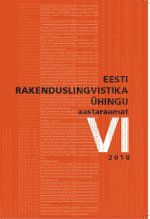Narratiivi aeg ja tõlke aeg: diskursiivne käsitlus
Time of narrative and time of translation: a discursive approach
Author(s): Triin Lõbus, Silvi TenjesSubject(s): Language and Literature Studies
Published by: Eesti Rakenduslingvistika Ühing (ERÜ)
Keywords: discourse analysis; text analysis; narratology; tense; aspect; Estonian; Spanish
Summary/Abstract: The current article explores temporal relations in fictional narratives by comparing original Spanish works with their translations in Estonian. The focus lies on the role of the so-called narrative imperfect as a device of style and narrative technique in Spanish. Furthermore, the article endeavours to address the problems and possibilities associated with transmitting the narrative imperfect in Estonian in such a way that the reader is able to experience the storyworld in the most similar way possible with respect to its original construction by the author in Spanish. The study is based on a sociocognitive approach. Accordingly, fictional narrative is seen as a sociocultural practice expected to follow certain conventions in creating and interpreting meaning. Interpreting temporal relations in fictional narrative requires relocation to the narrative now-point located within the storyworld. Therefore, the functioning of aspectual categories in a narrative concerns its interaction with this now-point. The narrative imperfect involves the rather exceptional use of the imperfective aspect in the case of a temporal progression of narrative now-point. The present study is intended to point out the main ways of how narrative imperfect can affect mental representations of the storyworld. In addition, the possibilities of expressing the same modifications by means of the Estonian language are discussed. The results of the analysis show that the use of narrative imperfect in Spanish is generally characterized by its contrast with the presupposed use of perfective aspect and with the surrounding context, resulting in modifications in the temporal structure as well as in the spatial dimension and particularly the viewpoint. The special representation of events created by the narrative imperfect is more easily transmittable to Estonian in case of a weak contrast. On the other hand, translation problems increase in the presence of a sharp contrast.
Journal: Eesti Rakenduslingvistika Ühingu aastaraamat
- Issue Year: 2010
- Issue No: 6
- Page Range: 157-174
- Page Count: 17
- Language: Estonian

